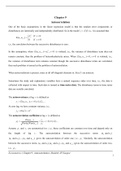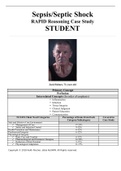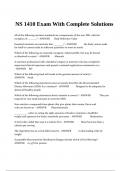Chapter 9
Autocorrelation
One of the basic assumptions in the linear regression model is that the random error components or
disturbances are identically and independently distributed. So in the model y X u, it is assumed that
u2 if s 0
E (ut , ut s )
0 if s 0
i.e., the correlation between the successive disturbances is zero.
In this assumption, when E (ut , ut s ) u2 , s 0 is violated, i.e., the variance of disturbance term does not
remain constant, then the problem of heteroskedasticity arises. When E (ut , ut s ) 0, s 0 is violated, i.e.,
the variance of disturbance term remains constant though the successive disturbance terms are correlated,
then such problem is termed as the problem of autocorrelation.
When autocorrelation is present, some or all off-diagonal elements in E (uu ') are nonzero.
Sometimes the study and explanatory variables have a natural sequence order over time, i.e., the data is
collected with respect to time. Such data is termed as time-series data. The disturbance terms in time series
data are serially correlated.
The autocovariance at lag s is defined as
s E (ut , ut s ); s 0, 1, 2,... .
At zero lag, we have constant variance, i.e.,
0 E (ut2 ) 2 .
The autocorrelation coefficient at lag s is defined as
E (ut ut s ) s
s ; s 0, 1, 2,...
Var (ut )Var (ut s ) 0
Assume s and s are symmetrical in s , i.e., these coefficients are constant over time and depend only on
the length of lag s. The autocorrelation between the successive terms (u2 and u1 )
(u3 and u2 ),..., (un and un 1 ) gives the autocorrelation of order one, i.e., 1 . Similarly, the autocorrelation
between the successive terms (u3 and u1 ), (u4 and u2 )...(un and un 2 ) gives the autocorrelation of order two,
i.e., 2 .
Econometrics | Chapter 9 | Autocorrelation | Shalabh, IIT Kanpur
1
,Source of autocorrelation
Some of the possible reasons for the introduction of autocorrelation in the data are as follows:
1. Carryover of effect, at least in part, is an important source of autocorrelation. For example, the
monthly data on expenditure on household is influenced by the expenditure of preceding month. The
autocorrelation is present in cross-section data as well as time-series data. In the cross-section data,
the neighbouring units tend to be similar with respect to the characteristic under study. In time-series
data, time is the factor that produces autocorrelation. Whenever some ordering of sampling units is
present, the autocorrelation may arise.
2. Another source of autocorrelation is the effect of deletion of some variables. In regression modeling,
it is not possible to include all the variables in the model. There can be various reasons for this, e.g.,
some variable may be qualitative, sometimes direct observations may not be available on the variable
etc. The joint effect of such deleted variables gives rise to autocorrelation in the data.
3. The misspecification of the form of relationship can also introduce autocorrelation in the data. It is
assumed that the form of relationship between study and explanatory variables is linear. If there are
log or exponential terms present in the model so that the linearity of the model is questionable, then
this also gives rise to autocorrelation in the data.
4. The difference between the observed and true values of the variable is called measurement error or
errors–in-variable. The presence of measurement errors on the dependent variable may also introduce
the autocorrelation in the data.
Econometrics | Chapter 9 | Autocorrelation | Shalabh, IIT Kanpur
2
, Structure of disturbance term:
Consider the situation where the disturbances are autocorrelated,
0 1 n 1
0 n 2
E ( ') 1
n 1 n2 0
1 1 n 1
1 n 2
0 1
n 1 n2 1
1 1 n 1
1 n 2
2
u 1
.
n 1 n2 1
Observe that now there are (n k ) parameters- 1 , 2 ,..., k , u2 , 1 , 2 ,..., n 1. These (n k ) parameters are
to be estimated on the basis of available n observations. Since the number of parameters are more than the
number of observations, so the situation is not good from the statistical point of view. In order to handle the
situation, some special form and the structure of the disturbance term is needed to be assumed so that the
number of parameters in the covariance matrix of disturbance term can be reduced.
The following structures are popular in autocorrelation:
1. Autoregressive (AR) process.
2. Moving average (MA) process.
3. Joint autoregression moving average (ARMA) process.
1. Autoregressive (AR) process
The structure of disturbance term in the autoregressive process (AR) is assumed as
ut 1ut 1 2ut 2 ... q ut q t ,
i.e., the current disturbance term depends on the q lagged disturbances and 1 , 2 ,..., k are the parameters
(coefficients) associated with ut 1 , ut 2 ,..., ut q respectively. An additional disturbance term is introduced in
ut which is assumed to satisfy the following conditions:
Econometrics | Chapter 9 | Autocorrelation | Shalabh, IIT Kanpur
3
Autocorrelation
One of the basic assumptions in the linear regression model is that the random error components or
disturbances are identically and independently distributed. So in the model y X u, it is assumed that
u2 if s 0
E (ut , ut s )
0 if s 0
i.e., the correlation between the successive disturbances is zero.
In this assumption, when E (ut , ut s ) u2 , s 0 is violated, i.e., the variance of disturbance term does not
remain constant, then the problem of heteroskedasticity arises. When E (ut , ut s ) 0, s 0 is violated, i.e.,
the variance of disturbance term remains constant though the successive disturbance terms are correlated,
then such problem is termed as the problem of autocorrelation.
When autocorrelation is present, some or all off-diagonal elements in E (uu ') are nonzero.
Sometimes the study and explanatory variables have a natural sequence order over time, i.e., the data is
collected with respect to time. Such data is termed as time-series data. The disturbance terms in time series
data are serially correlated.
The autocovariance at lag s is defined as
s E (ut , ut s ); s 0, 1, 2,... .
At zero lag, we have constant variance, i.e.,
0 E (ut2 ) 2 .
The autocorrelation coefficient at lag s is defined as
E (ut ut s ) s
s ; s 0, 1, 2,...
Var (ut )Var (ut s ) 0
Assume s and s are symmetrical in s , i.e., these coefficients are constant over time and depend only on
the length of lag s. The autocorrelation between the successive terms (u2 and u1 )
(u3 and u2 ),..., (un and un 1 ) gives the autocorrelation of order one, i.e., 1 . Similarly, the autocorrelation
between the successive terms (u3 and u1 ), (u4 and u2 )...(un and un 2 ) gives the autocorrelation of order two,
i.e., 2 .
Econometrics | Chapter 9 | Autocorrelation | Shalabh, IIT Kanpur
1
,Source of autocorrelation
Some of the possible reasons for the introduction of autocorrelation in the data are as follows:
1. Carryover of effect, at least in part, is an important source of autocorrelation. For example, the
monthly data on expenditure on household is influenced by the expenditure of preceding month. The
autocorrelation is present in cross-section data as well as time-series data. In the cross-section data,
the neighbouring units tend to be similar with respect to the characteristic under study. In time-series
data, time is the factor that produces autocorrelation. Whenever some ordering of sampling units is
present, the autocorrelation may arise.
2. Another source of autocorrelation is the effect of deletion of some variables. In regression modeling,
it is not possible to include all the variables in the model. There can be various reasons for this, e.g.,
some variable may be qualitative, sometimes direct observations may not be available on the variable
etc. The joint effect of such deleted variables gives rise to autocorrelation in the data.
3. The misspecification of the form of relationship can also introduce autocorrelation in the data. It is
assumed that the form of relationship between study and explanatory variables is linear. If there are
log or exponential terms present in the model so that the linearity of the model is questionable, then
this also gives rise to autocorrelation in the data.
4. The difference between the observed and true values of the variable is called measurement error or
errors–in-variable. The presence of measurement errors on the dependent variable may also introduce
the autocorrelation in the data.
Econometrics | Chapter 9 | Autocorrelation | Shalabh, IIT Kanpur
2
, Structure of disturbance term:
Consider the situation where the disturbances are autocorrelated,
0 1 n 1
0 n 2
E ( ') 1
n 1 n2 0
1 1 n 1
1 n 2
0 1
n 1 n2 1
1 1 n 1
1 n 2
2
u 1
.
n 1 n2 1
Observe that now there are (n k ) parameters- 1 , 2 ,..., k , u2 , 1 , 2 ,..., n 1. These (n k ) parameters are
to be estimated on the basis of available n observations. Since the number of parameters are more than the
number of observations, so the situation is not good from the statistical point of view. In order to handle the
situation, some special form and the structure of the disturbance term is needed to be assumed so that the
number of parameters in the covariance matrix of disturbance term can be reduced.
The following structures are popular in autocorrelation:
1. Autoregressive (AR) process.
2. Moving average (MA) process.
3. Joint autoregression moving average (ARMA) process.
1. Autoregressive (AR) process
The structure of disturbance term in the autoregressive process (AR) is assumed as
ut 1ut 1 2ut 2 ... q ut q t ,
i.e., the current disturbance term depends on the q lagged disturbances and 1 , 2 ,..., k are the parameters
(coefficients) associated with ut 1 , ut 2 ,..., ut q respectively. An additional disturbance term is introduced in
ut which is assumed to satisfy the following conditions:
Econometrics | Chapter 9 | Autocorrelation | Shalabh, IIT Kanpur
3












